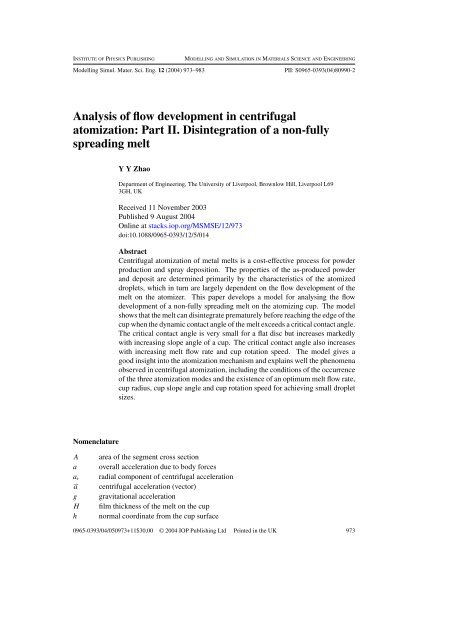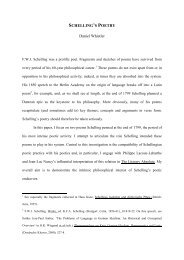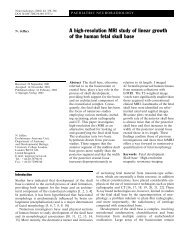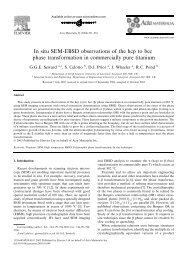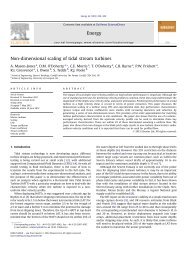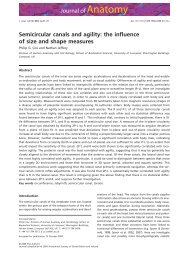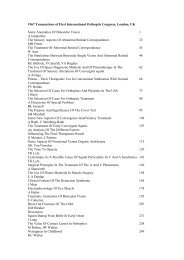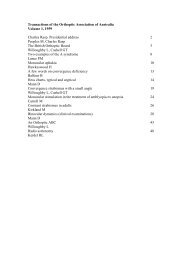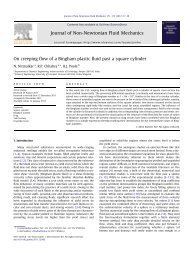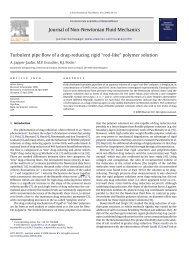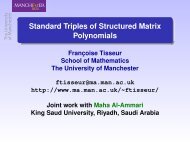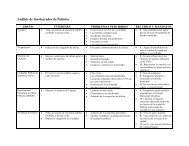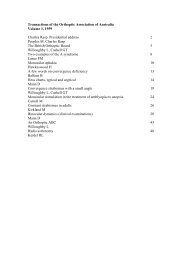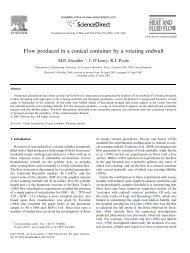Analysis of flow development in centrifugal atomization: Part II ...
Analysis of flow development in centrifugal atomization: Part II ...
Analysis of flow development in centrifugal atomization: Part II ...
Create successful ePaper yourself
Turn your PDF publications into a flip-book with our unique Google optimized e-Paper software.
978 Y Y ZhaoAt the middle <strong>of</strong> the segment, the <strong>in</strong>cl<strong>in</strong>ation angle ϕ = 0 and the correspond<strong>in</strong>g normalcoord<strong>in</strong>ate is therefore⎡⎤(s<strong>in</strong>h m = ⎣√ 2σ) 2 ϕo+ ρaρa πr σ (1 − cos ϕ o) − s<strong>in</strong> ϕ o⎦ . (10)πrAs the changes <strong>in</strong> the horizontal and normal coord<strong>in</strong>ates <strong>of</strong> the segment (y,h) follow therelation dy = ctgϕ dh, the area <strong>of</strong> the segment can be calculated us<strong>in</strong>gA = 2∫ πr0h dy = 2∫ hm0hctgϕdh. (11)To satisfy the mass conservation criterion, this area must be equal to the cross-sectional area<strong>of</strong> the melt film just before the dis<strong>in</strong>tegration takes place, i.e. A = 2πrH. Comb<strong>in</strong><strong>in</strong>gequations (1) and (11) gives∫ hm[ 3π 2 ] 1/3µQrhctgϕdh =. (12)02ρω 2 cos αGiven ρ, µ, σ , Q, ω, α and ϕ o , r becomes the only unknown parameter <strong>in</strong> equation (12) andcan be determ<strong>in</strong>ed. The radius that satisfies equation (12) is the radius at which the uniformmelt film on the cup starts to dis<strong>in</strong>tegrate <strong>in</strong>to ligaments and is designated as the ligamentformation radius, r c1 . Equation (12) can also be used to determ<strong>in</strong>e the operat<strong>in</strong>g conditionunder which the ligament formation radius co<strong>in</strong>cides with the cup radius, r o . The analyticalsolution <strong>of</strong> equation (12) is too complex. It is much more convenient to solve it by numericalmeans.3. Illustrations and discussionsTo illustrate the model predictions, liquid t<strong>in</strong> has been used as a model melt. The physicalproperties used <strong>in</strong> the calculations are specific density ρ = 6970 kg m −3 , viscosity µ =0.001 97 kg m −1 s −1 and surface tension σ = 0.57Nm −1 [9]. The operat<strong>in</strong>g parameters <strong>of</strong>the <strong>centrifugal</strong> <strong>atomization</strong> process are varied <strong>in</strong> the follow<strong>in</strong>g ranges: volume <strong>flow</strong> rate, Q,2.5 × 10 −6 –2×10 −5 m 3 s −1 ; cup rotation speed, , 50–1000 rps (revolutions per second); andcup slope angle, α, 0–75˚. A MATLAB programme has been created to solve equation (12) ata given set <strong>of</strong> conditions. It should be noted that for convenience the cup rotation speed shown<strong>in</strong> the illustrations is , with a unit <strong>of</strong> rps. In the calculations, however, ω = 2π, with a unit<strong>of</strong> radian s −1 , be<strong>in</strong>g used <strong>in</strong>stead.Figure 2 shows the variations <strong>of</strong> the ligament formation radius, r c1 , with the dynamiccontact angle, ϕ o , for a series <strong>of</strong> cup slope angles, α, at a fixed volume <strong>flow</strong> rate Q =1 × 10 −5 m 3 s −1 and a fixed cup rotation speed = 250 rps. The ligament formation radius isextremely sensitive to the dynamic contact angle with<strong>in</strong> a narrow range largely determ<strong>in</strong>ed bythe cup slope angle. For a fixed volume <strong>flow</strong> rate, cup rotation speed and cup slope angle, thereexists a critical contact angle, ϕ c , at which the ligament formation radius co<strong>in</strong>cides with the cupradius (r c1 = r o ). If the dynamic contact angle <strong>of</strong> the melt is smaller than the critical value(ϕ o ϕ c ), however, the meltwill have dis<strong>in</strong>tegrated before reach<strong>in</strong>g the edge <strong>of</strong> the cup. The melt at the edge <strong>of</strong> the cup willbe <strong>in</strong> the form <strong>of</strong> ligaments or even droplets. A convenient approach for exam<strong>in</strong><strong>in</strong>g the effects<strong>of</strong> the operat<strong>in</strong>g parameters <strong>of</strong> the <strong>centrifugal</strong> <strong>atomization</strong> process on the melt dis<strong>in</strong>tegrationis therefore to exam<strong>in</strong>e their effects on the critical contact angle.
Flow <strong>development</strong> <strong>in</strong> <strong>centrifugal</strong> <strong>atomization</strong>: <strong>Part</strong> <strong>II</strong> 979Figure 2. Variations <strong>of</strong> ligament formation radius, r c1 , with dynamic contact angle, ϕ o , at differentcup slope angles, α, atQ = 1 × 10 −5 m 3 s −1 and = 250 rps.Figure 3. Variation <strong>of</strong> critical contact angle, ϕ c , with cup slope angle, α, atr o = 0.03 m,Q = 1 × 10 −5 m 3 s −1 and = 250 rps.Figures 3, 4 and 5 show the variations <strong>in</strong> the critical contact angle, ϕ c , with the cup slopeangle, α, volume <strong>flow</strong> rate, Q, and cup rotation speed, , respectively. If not specified, theparameters other than the one <strong>in</strong> consideration are fixed as follows: cup radius r o = 0.03 m,volume <strong>flow</strong> rate Q = 1 × 10 −5 m 3 s −1 and cup rotation speed = 250 rps. For a flat disc(α = 0), the critical contact angle <strong>in</strong>creases with <strong>in</strong>creas<strong>in</strong>g melt <strong>flow</strong> rate and decreas<strong>in</strong>g cuprotation speed. However, it is very small <strong>in</strong> any case and ranges from 0.05˚ to 0.26˚ <strong>in</strong> thewide range <strong>of</strong> conditions considered <strong>in</strong> this paper. Us<strong>in</strong>g a cup can <strong>in</strong>crease the critical contactangle markedly, as shown <strong>in</strong> figure 3. For a cup (α 15˚), the critical contact angle <strong>in</strong>creaseswith <strong>in</strong>creas<strong>in</strong>g melt <strong>flow</strong> rate and cup rotation speed.Numerical calculation <strong>of</strong> the ligament formation radius is only possible if the dynamiccontact angle <strong>of</strong> the melt is known. However, it is very difficult to obta<strong>in</strong> a reasonably accurate
980 Y Y ZhaoFigure 4. Variation <strong>of</strong> critical contact angle, ϕ c , with melt volume <strong>flow</strong> rate, Q, atr o = 0.03 mand = 250 rps.Figure 5. Variation <strong>of</strong> critical contact angle, ϕ c , with cup rotation speed, , atr o = 0.03 m andQ = 1 × 10 −5 m 3 s −1 .contact angle under dynamic conditions either by theoretical estimation or by experimentalmeasurements. This model is therefore not <strong>in</strong>tended to give accurate predictions <strong>of</strong> the ligamentformation radius but rather to shed some light on the mechanisms by which the process<strong>in</strong>gconditions affect the melt dis<strong>in</strong>tegration and consequently the droplet size distribution.The dis<strong>in</strong>tegration process <strong>of</strong> the melt <strong>in</strong> <strong>centrifugal</strong> <strong>atomization</strong> can be envisaged fromthe <strong>development</strong> <strong>of</strong> the melt <strong>flow</strong> <strong>in</strong> relation to two critical radii. The melt <strong>flow</strong> is <strong>in</strong>itially acont<strong>in</strong>uous th<strong>in</strong> film. At r c1 , the melt film breaks up <strong>in</strong>to ligaments. The ligaments further breakup <strong>in</strong>to <strong>in</strong>dividual droplets at a second critical radius, def<strong>in</strong>ed as the droplet formation radius, r c2 .The three modes <strong>of</strong> <strong>atomization</strong>, namely direct droplet formation, ligament dis<strong>in</strong>tegration andsheet dis<strong>in</strong>tegration, found <strong>in</strong> <strong>centrifugal</strong> <strong>atomization</strong> can be well expla<strong>in</strong>ed by the relationship
982 Y Y ZhaoTherefore, a non-fully wett<strong>in</strong>g melt on a flat disc is most likely to dis<strong>in</strong>tegrate well beforereach<strong>in</strong>g the disc edge. Increas<strong>in</strong>g the cup slope angle <strong>in</strong>creases the ligament formation radiusand therefore may decrease the correspond<strong>in</strong>g film thickness and consequently the mean dropletsize. If the cup slope angle is big enough to ensure that the melt spreads fully on the cup,<strong>in</strong>creas<strong>in</strong>g the slope angle further has no benefits.The present model shows that the dynamic contact angle has a significant effect onthe <strong>atomization</strong> <strong>of</strong> the melt. Full wettability between the melt and the atomiz<strong>in</strong>g disc orcup is desirable for obta<strong>in</strong><strong>in</strong>g full spread<strong>in</strong>g and thus small droplets. In practice, however,full wettability does not exist. It is difficult to ensure an extremely low dynamic contactangle, required for full spread<strong>in</strong>g on a flat disc. Good spread<strong>in</strong>g <strong>of</strong> the melt can be achievedmore effectively by adopt<strong>in</strong>g an atomiz<strong>in</strong>g cup with an appropriate slope angle. In any case,the wett<strong>in</strong>g condition may prevent the film thickness from be<strong>in</strong>g reduced to below a certa<strong>in</strong>level. There might exist a lower limit to the primary droplet sizes obta<strong>in</strong>able <strong>in</strong> <strong>centrifugal</strong><strong>atomization</strong>.The present model expla<strong>in</strong>s well the existence <strong>of</strong> an optimum cup radius, cup slope angle,cup rotation speed and melt <strong>flow</strong> rate <strong>in</strong> <strong>centrifugal</strong> <strong>atomization</strong>. The optimum cup radius is<strong>in</strong> the vic<strong>in</strong>ity <strong>of</strong> the ligament formation radius, r c1 .Ifr o r c1 , however,<strong>in</strong>creas<strong>in</strong>g the cup radius has little effect on the droplet sizes but <strong>in</strong>creases the torque on thedriv<strong>in</strong>g motor. The optimum cup slope angle, cup rotation speed and melt <strong>flow</strong> rate are thosethat make the ligament formation radius approximate the cup radius. Lower cup slope angles,lower melt <strong>flow</strong> rates or higher cup rotation speeds lead to premature dis<strong>in</strong>tegration and thus alow efficiency. Higher cup slope angles, higher melt <strong>flow</strong> rates or lower cup rotation speeds,however, lead to <strong>atomization</strong> <strong>in</strong> the sheet formation regime and consequently coarse particles.4. ConclusionA model has been developed for analys<strong>in</strong>g the <strong>flow</strong> <strong>development</strong> <strong>of</strong> a non-fully spread<strong>in</strong>gmelt on the atomiz<strong>in</strong>g cup <strong>in</strong> <strong>centrifugal</strong> <strong>atomization</strong>. The model shows that the melt candis<strong>in</strong>tegrate prematurely before reach<strong>in</strong>g the edge <strong>of</strong> the cup when the dynamic contact angle<strong>of</strong> the melt exceeds a critical contact angle. The critical contact angle is very small for a flatdisc but <strong>in</strong>creases markedly with <strong>in</strong>creas<strong>in</strong>g slope angle <strong>of</strong> a cup. The critical contact anglealso <strong>in</strong>creases with <strong>in</strong>creas<strong>in</strong>g melt <strong>flow</strong> rate and cup rotation speed. The model expla<strong>in</strong>s wellthe phenomena observed <strong>in</strong> <strong>centrifugal</strong> <strong>atomization</strong>, <strong>in</strong>clud<strong>in</strong>g the conditions <strong>of</strong> the occurrence<strong>of</strong> the three <strong>atomization</strong> modes and the existence <strong>of</strong> an optimum melt <strong>flow</strong> rate, cup radius,cup slope angle and cup rotation speed for achiev<strong>in</strong>g small droplet sizes.AcknowledgmentsThe author would like to thank Mr John Dunkley and Dr Jiwei Xie for some helpful discussions.References[1] Zhao Y Y 2004 <strong>Analysis</strong> <strong>of</strong> <strong>flow</strong> <strong>development</strong> <strong>in</strong> <strong>centrifugal</strong> atomisation part I: film thickness <strong>of</strong> a fully spread<strong>in</strong>gmelt Modell<strong>in</strong>g Simul. Mater. Sci. Eng. 12 959[2] Xie J W, Zhao Y Y and Dunkley J J 2004 Effect <strong>of</strong> process<strong>in</strong>g parameters on powder size distribution andmorphology <strong>in</strong> <strong>centrifugal</strong> atomisation <strong>of</strong> t<strong>in</strong> Powder Metall. 47 168–72[3] Zhao Y Y, Dowson A L, Johnson T P, Young J M and Jacobs M H 1996 Advances <strong>in</strong> Powder Metallurgy &<strong>Part</strong>iculate Materials vol 3, ed T M Cadle and K S Narasimhan (Pr<strong>in</strong>ceton, NJ: Metal Powder IndustriesFederation) p 9.79


